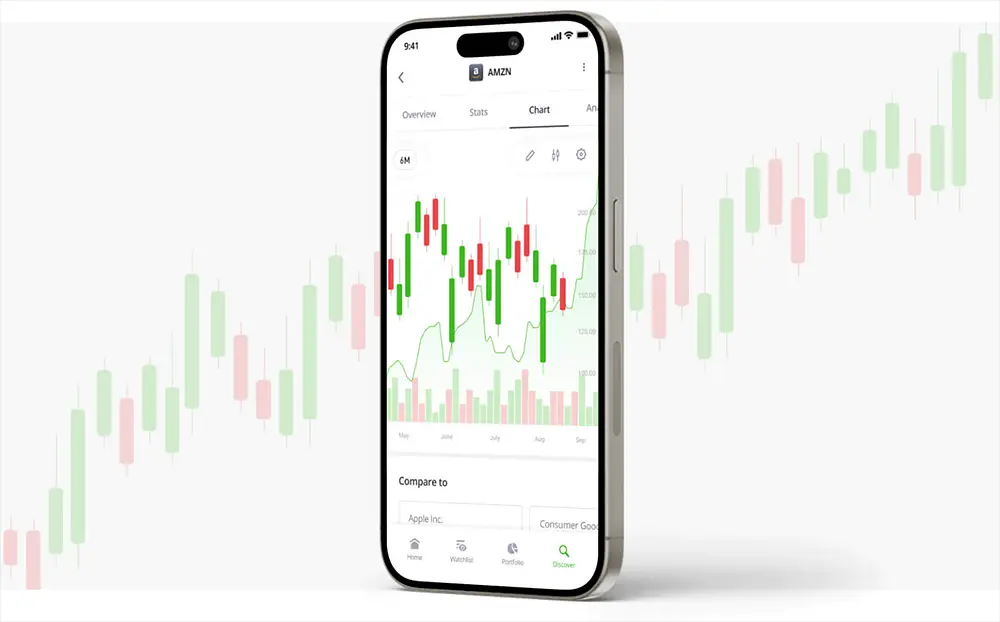Amazon trades on NASDAQ under the symbol AMZN. The company was founded by Jeff Bezos in 1994 and started as an online bookstore. Since then, it has evolved into the e-commerce and technology giant we know today.
Some important milestones in Amazon’s history:
- 1997: Initial Public Offering (IPO) at $18 per share
- 1999: Expansion beyond books
- 2005: Launch of Amazon Prime
- 2006: Introduction of Amazon Web Services (AWS)
- 2017: Acquisition of Whole Foods Market
Amazon has conducted four stock splits since its IPO, the most recent being a 20-for-1 split in June 2022, making the shares more accessible to retail investors.
How to Invest in Amazon Shares (Popular Methods)
There are several ways to invest in Amazon:
- Direct stock purchase: Buy actual shares through a broker. This gives you real ownership and voting rights, but requires higher capital.
- CFDs: Trade contracts-for-difference that track Amazon’s price without owning shares. CFDs provide leverage and short-selling ability, but also have higher risk.
- Options: Buy call/put options to speculate on Amazon’s future price. Options allow high leverage but are complex instruments.
- ETF: Exchange-traded funds that include Amazon in their portfolio, such as the Invesco QQQ Trust.
Comparison of trading methods and recommendations for choosing a strategy:
| Method | Advantages | Disadvantages |
|---|---|---|
| Direct purchase | Real ownership, voting rights | Higher initial capital, less leverage |
| CFD | Leverage, short selling | Financing costs, no real ownership |
| Options | Potential for high returns | Complexity, risk of total loss |
| ETF | Diversification, lower risk | Diluted returns, less control |
The choice of method will depend on your risk profile, available capital, and investment objectives. For long-term investors, direct purchase may be more suitable. More active traders might prefer CFDs or options for their flexibility and leverage.
Advantages and features of Amazon CFD trading

Amazon CFD trading offers several advantages:
Leverage: Allows trading with a fraction of the total position value.
Short selling: Profit from falls in the stock price.
Reduced costs: No traditional brokerage commissions.
24/5 access: Market open outside regular stock market hours.
How to buy Amazon stocks in India
For Indian investors, there are several ways to invest in Amazon shares:
- Open a trading account with an Indian broker offering access to US markets like Nasdaq. Top brokers include Zerodha, Upstox, 5Paisa Capital, etc.
- Complete KYC and fund your trading account in Indian rupees.
- Use the broker’s trading platform to search for the AMZN stock and place a buy order.
- Monitor your positions and set appropriate stop-losses and take-profits.
- Pay attention to currency conversion fees, US taxes, and India’s tax laws on foreign investments.
When selecting a broker, consider factors such as commissions, trading platform, analysis tools, and customer service.
Particularities of investing in India
Investing in U.S. stocks from India can present additional challenges:
- Local regulations: Ensure compliance with your country’s laws on foreign investments.
- Taxes: Consider the tax implications in both your country and the U.S.
- Currency conversion: Associated costs can affect your returns.
- Market hours: The time difference may require adjustments to your trading habits.
It’s crucial to choose a broker that specifically caters to Indian clients and offers support in local languages.
Does Investing in Amazon Stocks Make Sense?
Business lines, products and subsidiaries
Amazon operates in various sectors, including e-commerce, cloud computing services (AWS), electronic devices, entertainment, and supermarkets. Its important subsidiaries include Twitch, Zappos, Ring, and IMDb. This diversification has allowed Amazon to expand its presence in multiple markets and create an integrated ecosystem of products and services.
Strengths and weaknesses, market position and competition
Amazon stands out for its leadership in e-commerce and cloud computing, strong brand recognition, continuous innovation, and extensive distribution network. However, it faces challenges such as reduced profit margins in retail, regulatory scrutiny, and dependence on AWS for the majority of profits.
The company maintains a dominant position in the e-commerce market in the U.S. and several international markets, while AWS leads the cloud services market with a share of over 30%. Its main competitors include Walmart and Alibaba in e-commerce, and Microsoft Azure and Google Cloud in cloud computing.
Current price, dynamics and performance summary
In recent months, the stock has maintained an overall uptrend:
January 2024: $155.20
March 2024: $180.38
May 2024: $176.44
July 2024: $194.49
This increase reflects investor confidence in Amazon’s continued growth and dominant position in e-commerce and cloud computing.

Technical and fundamental analysis
Key charts, patterns and financial metrics
Technical analysis shows a long-term bullish trend for Amazon stocks, with key support around $180 and resistance near the all-time high of $201.20. The RSI (Relative Strength Index) indicates short-term overbought conditions.
Regarding financial metrics, Amazon has a market capitalization of $2.024 trillion, a P/E ratio of 54.63, revenue (TTM) of $590.74 billion, a net profit margin of 6.40%, and an ROE of 20.31%.
Evaluation of earnings reports and forecasts
Amazon has shown consistent revenue growth and improvements in profitability. In the first quarter of 2024, the company reported revenue of $143.3 billion, a 13% year-over-year increase, and net income of $9.9 billion, significantly higher than the $3.8 billion in the same period in 2023.
Analysts expect Amazon to continue its growth trajectory, driven by e-commerce expansion, accelerated growth of AWS, and improvements in operational efficiency. The analyst consensus suggests an average target price of $208.25 for the next 12 months.
Amazon’s dividend policy
Amazon currently does not pay dividends. The company has historically chosen to reinvest its earnings in business growth and new initiatives, rather than distributing dividends to shareholders. This strategy has allowed Amazon to maintain a high pace of growth and expansion into new markets.
Investment strategies and outlook
Long-term strategies for investing in Amazon include buy and hold to take advantage of long-term growth, dollar-cost averaging to mitigate volatility, and reinvesting gains. For the short term, investors could consider swing trading, scalping, or event trading, taking advantage of price fluctuations and important company announcements.
Most analysts maintain a positive view on Amazon. Recently, firms such as TD Cowen, Roth MKM, and Needham have reiterated their “Buy” ratings. Factors supporting these positive outlooks include continued dominance in e-commerce, accelerated growth of AWS, and potential in digital advertising and healthcare. However, investors should remain aware of potential challenges, such as growing competition and regulatory pressure.
Risks and factors affecting stock price
Market, economic, and company-specific risks
Market risks include general stock market volatility, changes in interest rates, and fluctuations in exchange rates. Economic risks encompass the possibility of a recession affecting consumer spending, inflation and its impact on operating costs, and changes in post-pandemic consumption patterns. Amazon-specific risks include intensifying competition in e-commerce and cloud, supply chain and logistics issues, and rising labor costs.
Regulatory and geopolitical factors
Amazon faces antitrust investigations in the U.S. and Europe, increasingly strict data privacy regulations, and the potential impact of trade tensions between the U.S. and China. Additionally, changes in tax policies affecting large tech companies could have a significant impact on Amazon’s profitability.
Frequently asked questions about investing in Amazon stocks
Where can I buy Amazon stocks?
You can buy Amazon stocks through regulated online brokers that offer access to U.S. markets.
How much does an Amazon stock cost?
As of July 12, 2024, the closing price of an Amazon stock was $194.49. However, this price fluctuates constantly during trading hours.
How can i buy shares in Amazon?
Indian investors can buy Amazon stocks through local brokers with access to international markets or global trading platforms that accept clients from India.
What has happened to Amazon stocks?
Amazon stocks have experienced significant growth in 2024, rising from $155.20 in January to $194.49 in July, driven by AWS’s solid performance and improved e-commerce profitability.
Why are Amazon stocks rising/falling?
Amazon stocks rise due to strong financial results, growth in AWS, and positive market expectations. Falls may be due to concerns about valuation, regulatory risks, or general economic conditions.
How much dividends does Amazon pay?
Amazon currently does not pay dividends. The company reinvests its earnings in business growth.
How to become an Amazon investor?
To become an Amazon investor, open an account with a broker offering access to U.S. stocks, deposit funds, and buy AMZN shares.
Is it worth investing in Amazon?
The decision to invest in Amazon depends on your financial goals and risk tolerance. Many analysts see long-term growth potential, but it’s important to do your own research and consider diversifying your portfolio.
| Aspect | Data |
|---|---|
| Market capitalization | $2.024 trillion |
| P/E ratio | 54.63 |
| Revenue (TTM) | $590.74 billion |
| Net profit margin | 6.40% |
| Dividend | Does not pay |
| Analyst consensus | Buy |
Investing in Amazon stocks offers exposure to one of the world’s most influential technology companies. However, as with any investment, it’s crucial to understand the associated risks and make informed decisions based on your personal financial goals and risk tolerance.
